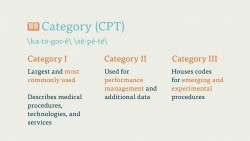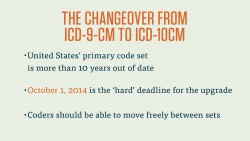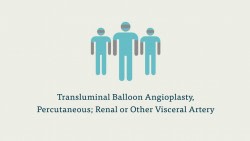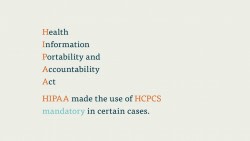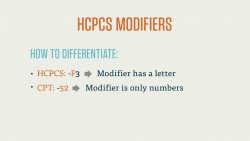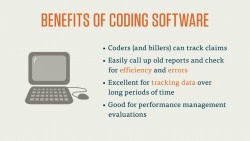Now that we’ve become a little more familiar with the HCPCS code set, it’s time to take a look at HCPCS modifiers.
In an earlier course we talked about CPT modifiers. HCPCS modifiers work in almost exactly the same way. The two code sets are so similar, in fact, that you can regularly use modifiers from one codeset to the other. The HCPCS modifier –LT, for example, is regularly used in CPT codes when you need to describe a bilateral procedure that was only performed on one side of the body.
HCPCS modifiers, like CPT modifiers, are always two characters, and are added to the end of a HCPCS or CPT code with a hyphen. When differentiating between a CPT modifier and a HCPCS modifier, all there’s one simple rule: if the modifier has a letter in it, it’s a HCPCS modifier. If that modifier is entirely numeric, it’s a CPT modifier.
HCPCS modifiers, like CPT modifiers, provide additional information about a procedure or service without redefining the service provided. The hundreds of modifiers established in the HCPCS code set cover everything from a procedure’s Medicare eligibility to
It would take far too long to list all of the HCPCS modifiers so, for the sake of simplicity, we’ll stick to the list of HCPCS modifiers found in the CPT manual. Download our ebook for a copy of this list.
As you can see, these modifiers cover a broad scope of information. While most of the codes correspond to parts of the body, there are also modifiers for ambulance services and mammograms. If you look at the full list of HCPCS modifiers, you’ll also find modifiers that describe everything from the Medicare eligibility of a procedure to the number of wounds dressed on a single patient.
As with CPT codes, we always want to use modifiers for functionality first, and information second. That is, you’ll want to list the HCPCS modifier that directly affects reimbursement first. Remember that while certain coding forms provide space for multiple modifiers, payers don’t always look at modifiers listed after the first two.
Note that certain HCPCS modifiers don’t “agree” with certain CPT modifiers. The most obvious example of this would be CPT modifier -50 and the HCPCS modifiers –LT and –RT. These modifiers are mutually exclusive: CPT modifier -50 describes a bilateral procedure, while HCPCS modifiers –LT and –RT describe which side of the body a procedure is performed on.
Let’s look at a simplified example of an HCPCS modifier in action.
A patient is suffering from bronchitis and asthma. This patient has difficulty breathing and calls his doctor. The doctor advises the patient go directly to the emergency room. The doctor arranges with the hospital, which in this case would be the healthcare provider, to pick up the patient in an ambulance with basic life support systems, or BLS.
In order to code this procedure on a claim, we’d look at the A-codes of HCPCS, where the ambulance codes reside. There we’d find A0428, for “Ambulance service, basic life support, non-emergency transport.” That’s our base HCPCS code.
Since, however, the ambulance was provided by the healthcare provider and not, say, called in via 911, we should add a modifier to explain this. This may seem like splitting hairs, but how an ambulance is called can greatly affect the amount of money owed for a procedure.
In this case, we’d look for a modifier that pertains to ambulance service. We’d find the –QN modifier, for “Ambulance service furnished directly by a provider of services”—in other words, the hospital, the service provider, sent the ambulance over to pick up our patient.
We’d end up with this code: A0428-QN for a basic life support ambulance service, non-emergency transport, furnished by the provider of services.
Let’s look at another example, this time using a combination of CPT codes, CPT modifiers, and HCPCS modifiers.
A patient requires the drainage of a large, felon abscess on the tip of the middle finger of his left hand. A “felon” abscess is a complicated infection of the pulp on the distal, or last, phalanx of the hand. During the procedure, however, the patient becomes agitated and doctor decides to discontinue the procedure.
If we’re coding this procedure, we’d first look at the procedure performed. This is a procedure done to a patient, so we’re probably going to find it the CPT codebook. It’s also a surgical procedure, so we’d find it in the Surgery section of the codebook. Specifically, this is an incision—it’s drainage made via a cut to the skin.
Once in the surgery section, we’d flip to the musculoskeletal subsection and find the Hand and Fingers field of codes. There we’d find the codes for incision and see that there are two codes for drainage of a finger abscess: the parent code 26010 for “drainage of finger abscess; simple” and the indented code 26011 for “drainage of finger abscess; complicated (eg, felon).”
The abscess we’re draining is complicated—it’s even listed in the code as an example of a complicated abscess. So, we’d select the indented code and put 26011 as our base code.
Now we’d need to look at the additional information. What’s the more important code for reimbursement: the place on the hand where the procedure took place, or the fact that the procedure was discontinued? In this case, it’d be the discontinued procedure.
We’d add the CPT modifier -53 for discontinued procedure, and then we’d look at the HCPCS modifiers for where on the body the procedure was performed. If you’ll recall, some of the HCPCS modifiers we listed earlier have to do with parts of the hand. We’ll look at these modifiers and find the one that fits our need: F2, for “left hand, third digit.”
So our code would look like this: 26011-53-F2: a discontinued drainage of a complicated abscess on the third digit of the left hand.
Coding with HCPCS modifiers won’t always be as easy as that example, but that one should give you a good idea of how these additions to the code set help us code to the highest level of accuracy.
That concludes this course on HCPCS modifiers. Like the rest of the HCPCS code set, it’s easy to get overwhelmed by the number and variety of options available. Once you get the hang of HCPCS’s organizational structure, though, you should be able to easily navigate this important, useful code.


